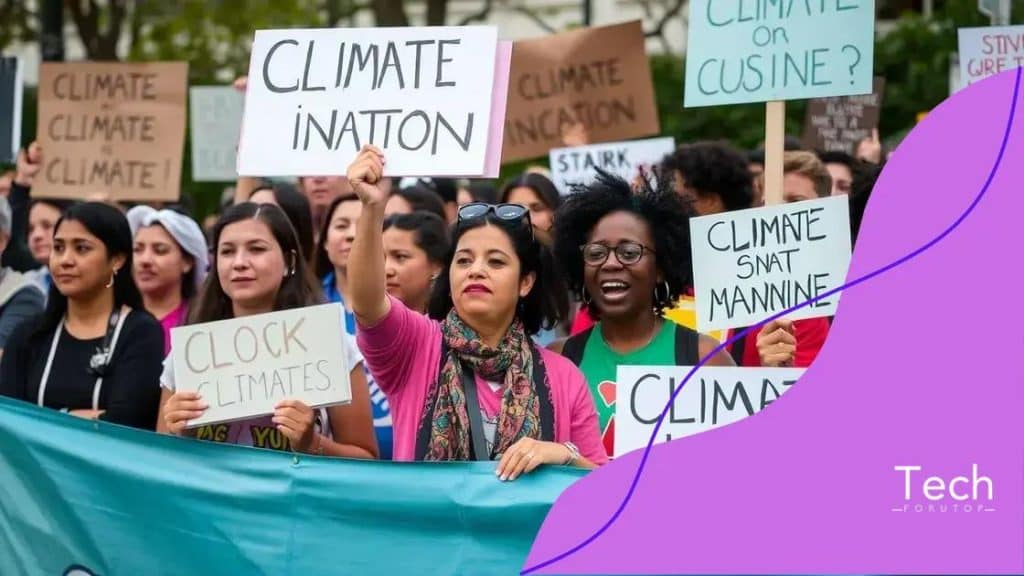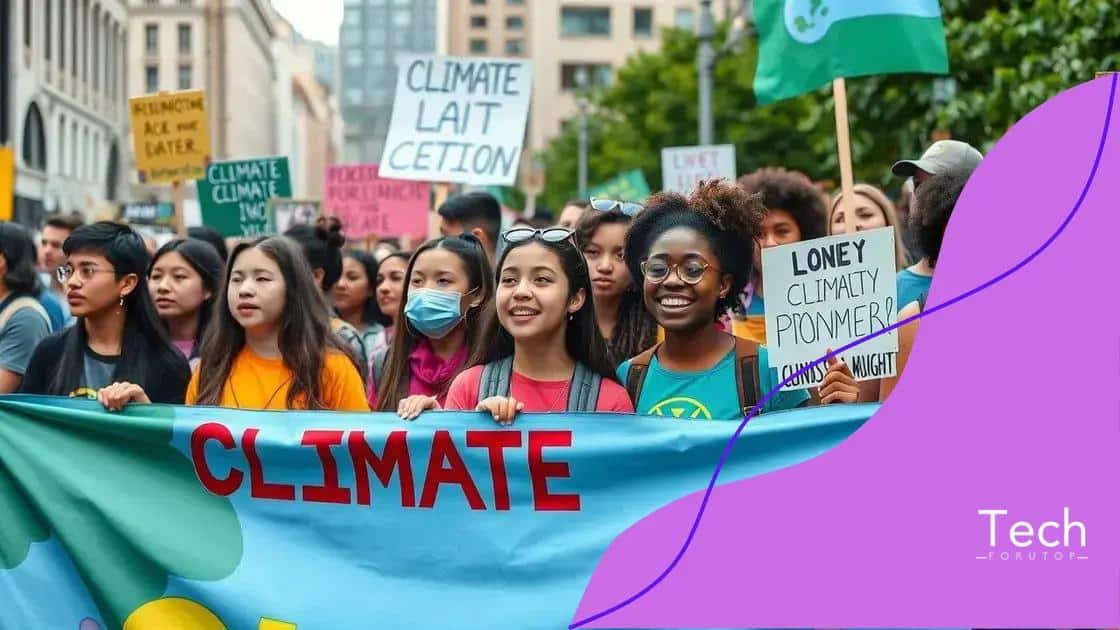Civil disobedience over climate inaction: a global response

Civil disobedience over climate inaction involves intentional law-breaking by activists to challenge unjust policies and draw attention to the urgent need for climate action.
Civil disobedience over climate inaction has emerged as a powerful response to the alarming pace of climate change. Have you ever wondered how small actions can spark significant societal shifts? Let’s delve into this phenomenon together.
Understanding civil disobedience in the climate crisis
Understanding civil disobedience in the climate crisis is essential for grasping how ordinary people are driving change. This form of protest allows individuals to express their concerns when governments fail to act meaningfully.
People engage in civil disobedience to make a strong statement about urgent issues that don’t get enough attention. By disrupting normal activities, they aim to draw public awareness and pressure politicians to act on climate change.
Key Principles of Civil Disobedience
The essence of civil disobedience lies in its four main principles:
- Non-violence: Actions should not harm others.
- Awareness: Protesters must highlight a specific injustice.
- Acceptance of consequences: Participants willingly face legal repercussions.
- Public demonstration: The act aims to cause a debate in society.
These principles guide activists in their mission to make climate-related issues visible. Understanding these foundations helps to appreciate the commitment behind such actions. What motivates these individuals? Often, it is the urgency felt about the climate crisis and the desire to inspire real change.
The Role of Community
Communities play a pivotal role in organizing such movements. By coming together, people build a support system that fuels motivation. Local leaders often emerge, guiding groups in specific goals and actions. This sense of unity enhances the impact of civil disobedience.
Moreover, collaboration amplifies voices and encourages more people to join the cause. Even small communities can create significant ripples when united. Working together, they challenge policies that contribute to climate inaction, demonstrating that collective voices have power.
In summary, understanding the foundations of civil disobedience reveals the powerful ways people seek justice in the climate crisis. This approach continues to evolve as more individuals recognize the critical state of our planet.
Historical examples of climate activism
Historical examples of climate activism provide valuable insights into how movements have shaped public policy and awareness. From grassroots efforts to major international campaigns, each instance reflects a growing concern for our planet.
One landmark moment occurred in 1962 with Rachel Carson’s book, Silent Spring. Her powerful writing highlighted the dangers of pesticides, awakening a generation to environmental issues. This pivotal work laid the foundation for the modern environmental movement.
Key Activism Milestones
Several key milestones illustrate the evolution of climate activism:
- The first Earth Day in 1970 engaged millions globally, raising awareness about pollution and conservation.
- In 1992, the UN Conference on Environment and Development marked a significant international commitment to sustainable development.
- The Paris Agreement in 2015 united countries to combat climate change, setting targets for reducing emissions.
- Recent youth-led movements, like the Fridays for Future campaign initiated by Greta Thunberg, have continued to rally support.
These milestones not only show the timeline of activism but also the increasing involvement of diverse groups in the fight for climate justice. The efforts of young people today echo those of previous activists, creating a rich legacy of environmental advocacy.
Grassroots Movements
Grassroots movements serve as a powerful reminder of community action in climate advocacy. Local organizations work tirelessly to address specific climate issues that affect their environment. These groups often mobilize people in targeted efforts, highlighting the impact of individual actions. Community gardens, local clean-ups, and educational workshops all serve to promote a sustainable future.
By educating fellow community members on environmental issues, these grassroots efforts show that change can start small and expand into larger movements. The connection between local activism and global awareness continues to strengthen, as communities understand their role in the larger fight against climate change.
Overall, studying historical examples of climate activism not only inspires current movements but also emphasizes the importance of sustained engagement in environmental issues.
The role of youth in climate protests

The role of youth in climate protests has become increasingly vital in recent years. Young activists are at the forefront of demanding action on climate change, showing a level of commitment that inspires many. Throughout history, youth movements have challenged the status quo, and today is no different.
One of the most notable figures is Greta Thunberg, whose Fridays for Future campaign has mobilized millions around the globe. This initiative started with her solitary protest outside the Swedish parliament, emphasizing that young voices can create significant change.
Key Contributions of Youth Activists
Youth activists have made important contributions to the fight against climate change:
- Raising awareness: Young people utilize social media platforms to spread information quickly.
- Organizing protests: They often lead large-scale demonstrations that attract worldwide attention.
- Engaging with policymakers: Youth activists demand accountability from leaders and push for stronger climate policies.
- Building community: They create networks that encourage collaboration and support among like-minded individuals.
Young activists’ abilities to mobilize communities highlight how they serve as change agents. They express deep concern for their future, making their involvement in climate protests urgent and meaningful. Their dedication also fosters intergenerational dialogue, encouraging adults to join in on climate action.
Impacts on Policy and Society
The impact of youth-led movements on policy is significant. Their activism often leads to increased media coverage and public interest. This momentum can shift political agendas, as fewer politicians can ignore the energy and passion of a motivated youth. Regularly, youth protesters remind adults and decision-makers of their responsibility to future generations.
Moreover, youth protests can lead to tangible outcomes, such as cities declaring climate emergencies or governments pledging to reach net-zero emissions by a specific date. The emergence of youth-led initiatives shows that the next generation is prepared to address the challenges ahead and insists on being heard.
In essence, the role of youth in climate protests is crucial. Their energetic and committed approach fosters an environment where change can happen, proving that anyone can make a difference in the climate crisis.
Legal implications of civil disobedience
The legal implications of civil disobedience are critical for understanding how activists navigate protests. Engaging in civil disobedience means intentionally breaking certain laws to challenge their fairness or morality. It raises important questions about justice, accountability, and the balance between rights and responsibilities.
Activists often accept the possibility of arrest or fines as part of their commitment. This risk underscores their dedication to advocating for pressing issues like climate change. Understanding the laws in their local area is essential for these participants. Some laws may be violated more than others depending on the context of the protest.
Potential Legal Consequences
Those who engage in civil disobedience can face various legal consequences, including:
- Arrests: Participants may be taken into custody during protests, which can lead to criminal charges.
- Fines: Many jurisdictions impose fines for specific offenses related to protest activities.
- Criminal charges: Violating laws can result in misdemeanor or felony charges, depending on the severity of the action.
- Legal proceedings: Many activists may need to attend court hearings or face legal representation.
Understanding these potential legal outcomes is vital for anyone considering civil disobedience. Knowledge of local laws helps activists prepare for the possibility of legal action and advocate for their rights effectively.
Defenses and Justifications
Activists often argue that civil disobedience is justified in the face of unjust laws. Historical figures like Martin Luther King Jr. emphasized the importance of moral responsibility over legal compliance. They argue that peaceful protests draw attention to necessary changes that should be made by governments and institutions.
Moreover, there is a long-standing tradition in democratic societies that allows for civil disobedience as a legitimate form of political expression. Participants may appeal to higher ethical standards, arguing that obeying an unjust law is itself a moral failure.
The intersection of legal implications and ethical considerations creates a complex environment for activists. It shows the importance of carefully weighing the potential risks and benefits before taking action. Engaging in peaceful civil disobedience can challenge lawmakers and highlight issues like climate inaction effectively, but those involved must be prepared for the consequences.
How to get involved in climate activism
Getting involved in climate activism is an empowering way to contribute to a sustainable future. Many people wonder where to start, and the good news is there are countless opportunities to make a difference. Whether you are a student, a professional, or a concerned citizen, your efforts can play a vital role in this global movement.
One effective way to begin is by educating yourself about climate issues. Understanding the science behind climate change helps articulate arguments and prompts meaningful conversations. You can read books, watch documentaries, or follow reputable online resources to gather information.
Ways to Take Action
Consider these practical steps to engage in climate activism:
- Join local organizations: Many communities have groups dedicated to promoting environmental sustainability. Collaborating with others amplifies your impact.
- Participate in protests: Attending climate marches or events can raise awareness and show policymakers the public’s commitment to change.
- Volunteer: Offer your time to organizations focused on conservation or climate education. This hands-on experience enhances your understanding.
- Advocate for policy change: Contact your local representatives to voice your concerns. Support legislation that aims to combat climate change.
Social media can also be a powerful tool for activism. By sharing information and raising awareness online, you can reach broader audiences. Use platforms like Twitter, Instagram, and Facebook to connect with like-minded individuals and organizations.
Engaging the Youth
Young people are central to climate activism. Schools and universities often sponsor initiatives and programs that encourage students to engage with environmental issues. Joining or starting a club can help rally support among peers.
Remember, climate activism doesn’t always require large, public actions. Even small efforts make a difference, whether it’s reducing your carbon footprint or advocating for greener policies in your community. Collective action starts with individual commitment.
By taking proactive steps to get involved, you can become part of a larger movement focused on creating a sustainable planet for future generations.
FAQ – Frequently Asked Questions about Climate Activism
What are the first steps to get involved in climate activism?
Start by educating yourself about climate issues and finding local organizations to join. You can also participate in community events.
How can social media help in climate activism?
Social media allows you to share information, connect with like-minded individuals, and mobilize support for climate events and protests.
Why is youth involvement important in climate activism?
Youth involvement is crucial as they represent the future. Their passion and energy can inspire change and hold leaders accountable for climate action.
What kind of activities can I do as a climate activist?
You can volunteer, attend protests, contact policymakers, and promote sustainable practices in your community.





